The Tragedies of Ballyconnell
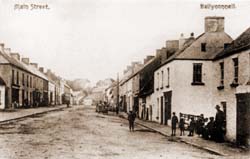
John Dorney reports on a series of tragedies in the border area in 1923 during the Irish Civil War.
On January 6th, 1923 an anti-Treaty IRA Volunteer from Roscommon, Michael Cull, was killed during a raid on Ballyconnell, County Cavan.
Cull, was part of a contingent of 50-70 anti-Treaty fighters holed up in the Arigna Mountains. As well as guerrilla attacks against the forces of the Irish Free State, one of their most frequent actions, out of necessity, was raids on civilian targets for supplies.
In reprisal for the shooting dead there of one of their comrades, Michael Cull, an anti-Treaty IRA column sacked the small town of Ballyconnell in February 1923, shooting dead two civilians.
Cull, according to the local newspaper, was holding up Ovens’ hardware and grocery shop in Ballyconnell when he was shot dead by a plain clothes Free State officer.[1] The National Army later derisively referred to, ‘the shooting of a looter named Cull … He and others were raiding in Ballyconnell when a couple of officers who were in the area got in touch with them. This gang of Irregulars have been in the mountains for several months past.[2]
Ballyconnell, was a small town in western County Cavan. According to the 1911 census it was populated by 125 families, or in the region of 600 people, and was according to local pro-Treaty TD Sean Milroy, ‘in the values of country towns, a very considerable centre of county life’.[3]
Since 1921 it had been wedged up against the new border with County Fermanagh and Northern Ireland to the north by the Arigna Hills to the south and west. At this time, as civil war raged south of the border, and with no effective police or military presence, Ballyconnell was particularly vulnerable to the depredations of armed groups of various allegiance.
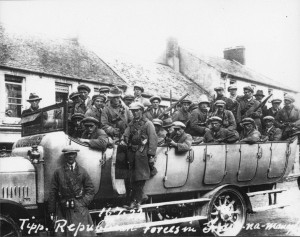
Michael Cull’s death was by no means the end of Ballyconnell’s troubles, however. The anti-Treaty column based in the Arigna hills, composed of Volunteers from Roscommon, Leitrim and Cavan (which included Michael Cull’s brother James) and led by Ned Bofin, visited a ferocious revenge on the small town for the death of Michael Cull.
Almost exactly a month later, on the morning of February 5th, 1923, at about 7am, 50 well-armed anti-Treaty IRA fighters descended on Ballyconnell from the hills in a military lorry and several cars. The guerrillas, armed with rifles and three machine guns, stopped the train to nearby Ballinamore so that word would not get out to adjacent Free State garrisons and then went in search of those they held responsible for Cull’s death.
At Oven’s grocery, the proprietor, William Ovens was shot through the thigh and badly wounded. One of his employees, William Ryan was dragged out and shot dead. According to the local press, the guerrillas shouted, ‘was it you who shot Cull?’ at Ryan before they shot him. His 80 year old father followed the fighters through the streets, shouting ‘murder, ‘murder’.
Sean McGrath, an Irish language teacher, originally from Galway, was also dragged out of bed and shot dead, apparently for no other reason than that he was lodging at the home of Free State supporter, John Dunn.
The guerrillas proceeded to bomb and burn out three shops, including the car dealership and the Post Office, and to smash the windows of the other premises with shots and rifle butts. The Ulster Bank branch was robbed of £200 and two Ford cars were seized. After a rampage of 35 minutes, the IRA column re-mounted their vehicles and headed back towards the Arigna hills, leaving the little town partially in flames, pockmarked with bullet holes and mourning the death of two of its citizens.[4]
According to the pro-Treaty National Army, ‘Our troops in Belturbet got word of the raid, and immediately set out in all their transport. They were joined en route by two Fords of troops from Cavan, and all proceeded to Ballyconnell, where they arrived shortly after 9 o’clock. They followed the Irregulars past Ballinamore, but failed to get in touch with them.’[5]
‘A particular kind of madness’
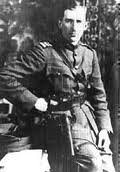
The ruthlessness of the reprisal at Ballyconnell – the premeditated assault on civilians – shocked pro-Treaty opinion. For the Free State government it exemplified the irrationality and criminality of what they called the ‘Irregulars’. Richard Mulcahy, Minister for Defence and Commander in Chief of the National Army stated;
‘Actions such as took place at Ballyconnell disclose a particular type of madness in the country that the country and the Government, if they face the fact of what a dangerous type of madness it is, cannot hope to cope with by an Army of 35,000 men. … there is this particular type of madness amongst a section of the people in the country who are armed, who are supported in their madness by feeling that they are following an ideal and by gathering to themselves all the phrases and all the words that have supported our national struggle in the past.’
Such ‘madness’ justified the government’s repressive measures, particularly the executions of republican prisoners which had been going on since November of the previous year. Mulcahy continued;
‘You can only meet that madness and that destruction that is there by realising that it is there and by realising that if we catch any of those men who came into Ballyconnell the other day and if we deal with them in the way in which this Government has decided to deal with them—that is by charging them with the offence, and if they are found guilty of it, by executing them’.
Similarly for Kevin O’Higgins, Minister for Home Affairs and hard-line supporter of the executions policy; ‘I want to combat the view that it was a natural thing to expect that a body of Irishmen would descend upon this little town and proceed to murder their fellow-citizens. It was not a natural thing. It is perhaps the most unnatural thing that has happened since this unnatural strife began.’[6]
For the Free State government the attack on Ballyconnell exemplified the cruelty and irrationality of the ‘Irregular’ campaign.
Within a week, a National Army expedition was dispatched to the West Cavan/ Leitrim area in considerable strength to root out Ned Bofin’s column, which had carried out the Ballyconnell raid. They reported that ‘the people are delighted at our presence and their only fear is that we might leave’ but were afraid to give information’. ‘Our only concern’, they reported, ‘is the remarkable agility of the Irregulars in retreating from an engagement with us.’[7]
If one were to believe the National Army version, the ‘Irregulars’ were simply cowardly bandits without any public support and the conflict in the border region would evaporate with the presence in strength of government troops. And were one to take the Ballyconnell reprisal alone this would appear to make sense. However looked at a little more closely, it is clear that the Civil War in this region was a complex web of national and local conflicts, that the Ballyconnell incident was only the culmination of the collapse of Free State authority in the area over several months.
The Civil War in the border region
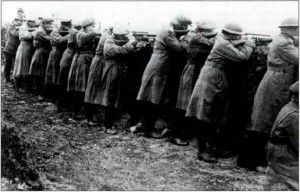
The Civil War along the border had a curious dynamic. For one thing, practically up until the outbreak of hostilities over the Treaty in the 26 counties, IRA units of both pro and anti-Treaty sympathies had been engaged in more or less open war with the Ulster Special Constabulary on the other side of the new border with Northern Ireland.
For this reason, IRA columns in the area during the Civil War were considerably better armed than they had been in the 1919-21 war against the British. As elsewhere in Ireland the IRA around the border split over the Treaty in early 1922 but open hostilities broke out in late June 1922 after the government attack on the anti-Treaty position in the Four Courts in Dublin.
In the Dáil, Kevin O’Higgins blamed Frank Aiken, commander of the IRA Fourth Northern Division for the attack on Ballyconnell, ‘one can only surmise that this was the act of Mr. Frank Aiken and his band— that mad dog who has been rushing in and out across the Border for many months.’[8]
The Civil War in the rural border region was, under the surface, a complex mixture of national, local and agrarian conflicts.
But in fact Aiken had had nothing to do with events in West Cavan and Leitrim. Aiken commanded dispersed groups of guerrillas in the countryside north of Dundalk and into County Monaghan and eastern Cavan. Having taken Dundalk in August 1922, but been unable to hold it, he fought his own localised Civil war against Free State forces in that part of the border region.
Effectively, West Cavan and County Leitrim and north Longford formed a separate theatre of anti-Treaty IRA operations. The rugged terrain around the Arigna mountains had proved a magnet for anti-Treaty fighters on the run from the surrounding counties who had coalesced under the command of Ned Bofin.
Richard Mulcahy told the Dail; ‘Anybody who knows the hinterland of mountains lying behind Ballinamore and Ballyconnell will understand that for the work we have to do in that area we have not sufficient troops effectively to control those mountains and to get that band of Irregulars that we know have been hiding there for some time.’ He also blamed the lenience of the existing Free State garrisons who had, ‘ contrary to orders and contrary to the spirit of discipline in the Army, been carrying on a sort of negotiations with them … simply because, just like other people who are not soldiers, they refused to believe these people were as black as they are’.[9]
The anti-Treaty IRA in the border region drew support partly from intervening in land disputes on the side of poor tenant farmers and those who felt their families had been unjustly evicted from their land in the past.
While in the border region, the anti-Treatyites’ cause must have seemed much more straightforward than elsewhere – opposition to the new border, confirmed under the Anglo-Irish Treaty, that now ran through their townlands and villages – in practice on the ground local loyalties were considerably more complicated than simply support for an Irish Republic or united Ireland. This rural area was one of the poorest parts of Ireland.
Starting in mid 1922 local authorities in Leitrim were warning of famine in the area and petitioning the Provisional Government in Dublin for emergency food aid to the region. [10] In Cavan an Agricultural Commission found in March 1923 that the small farmer lived in a chronic state of malnutrition and as a result was ‘incapable of sustained physical effort made by people of previous generations’[11]
The area had seen two bouts of intense land agitation in living memory – the ‘Land War’ in the 1880s and ‘Ranch War’ in the 1900s. Land hunger had been calmed somewhat by the Wyndham Act of 1908 which had allowed tenant farmers to buy their own land off landlords with long term loans, but a considerable number of ‘unpurchased’ estates remained in the region and since late 1921 many of them had been on rent strike, tying to pressurise their landlords into selling to their tenants. In the Ballyconnell area alone for instance 40 families petitioned to be awarded land in early 1922[12].
On top of that, the legacy of decades of land agitation had left a poisonous tangle of local disputes over land, which, in the lawless conditions of 1922-23, often exploded into violence. One member of an Evicted tenants Association at Cootehill spoke about the ‘need to recover the land from which our fathers and grandfathers were thrown off without law or justice’. Sometimes, though by no means always, this had a sectarian tinge. In April 1922 for instance, before the onset of Civil War, 20 armed men evicted a Protestant family, the Elkins, in favour of a Catholic one, the McMahons, who had been evicted from the holding 65 years previously.[13]
There was also the added social pressure caused by Catholic refugees fleeing from the violence in Northern Ireland, who sometimes pressured the IRA into displacing Protestant farmers to accommodate the northern refugees. In May 1922, three refugees from Belfast were convicted at Ballyconnell of intimidating Protestant farmer, Robert Crawford, whom they told to ‘go back to the six counties’.[14]
According to National Army Intelligence, a major part of the ‘Irregulars’ appeal lay in their taking sides with evicted or otherwise aggrieved farmers in land disputes. Citing a case in November 1922 in which ’17 armed Irregulars’ visited a farmer named Byrne in Cavan and forced him to sign over his land to one of their supporters, the Army concluded, ‘The Irregulars are taking advantage of the present state of the country to annex a farm for one of their supporters’.[15]
Finally Arigna itself was unusual in that it housed a coal mine, which according to National Army reports, was ‘taken from its owner Mr Layden by [IRA commander] Bofin and handed over to a family named McTiernan though they had no legal claim to it’.[16]
Whether due to social discontent in the area, or perhaps simply because of the weakness of Free State garrisons in the area, in late 1922 and early 1923, state authority in Leitrim and West Cavan all but collapsed.
A collapse of the Free State authority
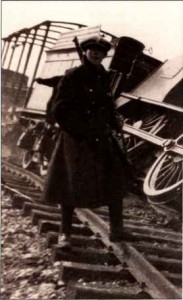
Ned Bofin’s IRA column in these months raided with impunity from their lair in the Arigna mountains, repeatedly humiliating Free State garrisons in the county towns.
Beginning in late 1922 the anti-Treaty column based in Arigna began systematic dismantling of the Free State security apparatus in the region. In November 1922 Ballinamore Civic Guard (police) station was held up and the Guards’ uniforms taken.
Emboldened by their easy victory over the unarmed Guards, on December 8, the anti-Treatyites attacked and overpowered the Free State military garrison at Carrickonshannon, killing one soldier (a civilian was also killed in the exchange of fire) and seizing the arms and motor transport of the soldiers.[17]
There were further attacks on barracks at Dowra and Manorhamilton before Bofins’ men had their greatest coup, at Ballinamore on January 28 1923. There, the barracks was taken after a short fire fight and then blown up. The train station was also destroyed and as well as losing their arms and tenders, the 35 Free State soldiers were rounded up and taken back the Arigna mountains as prisoners.[18]
The anti-Treaty IRA column based in the Arigna mountains raided freely into counties Leitrim and Cavan in late 1922 and early 1923, all but dismantling the Free State control over the area
In these conditions, the fledgling Free State could not function even minimally and it was reported in early 1923 that no tax had been collected for over a year in Leitrim. Tax collectors reported that it was too dangerous in the face of ‘organised opposition’. Furious, the Dublin government ordered them to ‘proceed with collection at once’ or be sacked.[19]
Although it is clear that in this region the anti-Treaty guerrillas did have some social support for various reasons, they did also prey to some extent on the civilian population even before the raid on Ballyconnell.
On November 13th, 1922, a civilian, James Martin was shot dead by armed raiders from Leitrim at his home at Drumcar, County Cavan and on December 10, 1922, there was a ‘large scale raid’ on Black Lion, Cavan, by 60 guerrillas, who ‘systematically cleared out’ the shops of supplies, and kidnapped a Free State supporter, Doctor Hamilton. In response to this on the other side of the border, The Ulster Special Constabulary closed the border crossings by blowing up the bridges across the frontier.[20]
So while the shocking events at Ballyconnell on February 5th 1923 were the catalyst for the dispatch of Free State forces in strength to West Cavan and Leitrim, it may have been necessary for the pro-Treaty authorities to assert their control over the region in arms sooner or later in any case.
The Special Military Area: February to March 1923
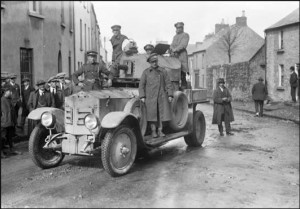
In the wake of the raid on Ballyconnell, the West Cavan and Leitrim area was declared a Special Military area and under the command of Dan Hogan, over 300 Free State soldiers, mostly from the 8th Infantry Battalion, based in Dublin, equipped with five Lewis machine guns, motorised transport and an armoured car were sent to scour the Arigna mountains and to enforce the previously weak authority of the Free State in the region.[21]
They found the existing Free State garrisons weak, consisting of 110 poorly supplied soldiers in two old police barracks at Ballyfarnon and Keadew.
In response to the anti-Treaty attack on Ballyconnell a well armed Free State force was sent from Dublin to clear the Arigna mountains of guerrillas.
While Ned Bofin’s column was relatively well armed by guerrilla standards it could not stand up to a force as large and well equipped as Hogan’s. As the Free State troops advanced there were only scattered skirmishes in the Arigna mountains. The National Army thought that, ‘The Irregular morale is very poor, their organisation is completely shattered by the presence of the military in the area’.
Most of the guerrillas retreated further west in to Roscommon and Sligo. However a steady stream were arrested, including Ned Bofin’s brother Paul.
There was however one more incident that brought the series of tragedies set off by the death of Michael Cull at Ballyconnell on January 7 1923 to a close. As the National Army troops traversed the Arigna hills they blew up the dugouts and mine tunnels where the guerrillas had been camped out. One such dugout was inhabited at the time by two IRA Volunteers, Patrick Tynan and James Cull, the brother of Michael. Both died in the explosion. Their funerals were raided by a party of Free State troops in an armoured car, who lined up and searched all the male mourners [22]
Ned Bofin himself, who had been nicknamed in the press, ‘the Irish De Wet’ (after the Boer guerrilla leader of 1899-1902) was captured on March 25th 1923.[23]
This marked the end of the Special Military area and from the Free State point of view, the pacification of the West Cavan/Leitrim area. In practice however, once Hogan’s column had been withdrawn, many IRA guerrillas drifted back to the area and the miserable cycle of raids and reprisals sputtered on until the end of the Civil War (with Frank Aiken’s order to the IRA to ‘dump arms’) in May 1923. Not long after Bofin’s arrest for example and possibly in reprisal, a civilian, Muldoon, and an off duty soldier, Fitzgerald, were shot and killed by the IRA in Leitrim. [24]
James Cull, the brother of Michael, whose death had sparked off the raid on Ballyconnell was blown up in his dugout with another IRA man, Patrick Tynan.
In response to the Free State threat to begin executions of anti-Treaty fighters in Leitrim, a notice was posted threatening that if, ‘any soldier of the IRA Third Battalion be executed all doctors, priests, ministers and natives of County Longford will have to clear out within 24 hours… any person assisting the Free State in any way or giving information which may lead to the capture of a soldier of the IRA will be subject to the death penalty. Any farmers with sons in the Free State Army’ is to clear out of the area 24 hours after the execution takes place’.[25]
The noticed threatened a chillingly wide section of the rural middle class but also gives an interesting insight into who the anti-Treatyites believed their enemies to be. Ultimately no State executions were carried out in either Cavan or Leitrim.
Social and agrarian discontent also continued however and a section of the Free State’s Special Infantry Corps – a unit raised to deal with social unrest – was sent to the border region to collect unpaid taxes and rents and to reverse illegal land seizures. By the summer of 1923, National Army Intelligence was reporting that the Special Infantry Corps was ‘having a very bad effect on the civil population in most districts where it is stationed’.[26]
Ned Bofin the leader of the Arigna column was arrested in March 1923 but Civil War violence continued at a low level after the main National Army force had left the area
Anti-Treaty support in the region did not disappear after the Civil War. In the General Elections of 1923, The Leitrim- Sligo constituency elected two pro-Treaty Cumman na nGaedheal TDs and also two anti-Treaty Republicans, one of whom, Samuel Holt topped the poll. Cavan elected on pro and one anti-Treaty candidate along with a Farmers’ Party candidate. A stubborn well of republican support remained.[27]
Epilogue
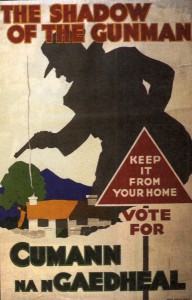
The events in and around Ballyconnell in early 1923 were truly shocking to Irish contemporaries, even in the context of the Civil War. To pro-Treaty partisans the raid on Ballyconnell in February confirmed the lawlessness and, as Richard Mulcahy put it, ‘the madness’ of the anti-Treaty campaign against the Free State.
Unlike the events in Kerry of the same period, which loomed large in republican commemorations in the decades after the Civil War and which spawned Dorothy McArdle’s well-known book ‘The Tragedies of Kerry’, the Civil War in the border region left no tangible trace in popular Irish memory.
They do show however a number of important things about the Irish Civil War as it was experienced on the ground. The conflict was often not a straightforward matter of pro versus anti-Treaty fighters but often also a confusing amalgam of local rivalries and animosities that became lethal in conditions of armed conflict.
Above all, what the series of incidents along the border in early 1923 show is that despite the relatively low body count, the Civil War was time of bitterness fear and loss among civilians as well as soldiers and guerrillas in much of Ireland.
References
[1] Anglo Celt January 13, 1923
[2] Quoted by Richard Mulcahy in Dail Debates 8 February 1923
[3] 1911 Census results online here http://www.census.nationalarchives.ie/pages/1901/Cavan/Ballyconnell/Ballyconnell/, Sean Milroy in Dail Debates, 7 February 1923
[4] Anglo Celt January 13, 1923, National Army report, quoted by Richard Mulcahy in Dail debates, 8 February 1923.
[5] Dail debate, 8 February 1923
[6] Dail Debates February 7 and , 1922.
[7] National Army report on the Special Military Area in Cavan and Leitrim, February 7 to 20 March 1923, Cathal Brugha Barracks archive file cw/ops/07/12
[8] Dail Debates, 7 February 1923
[9] Dail Debates 8 February 1923
[10] Anglo Celt June 24, 1922
[11] Anglo Celt, March 24, 1923
[12] Anglo Celt February 25, 1922
[13] Anglo Celt April 29, 1922
[14] Anglo Celt May 12 1922
[15] National Army Reports, Eastern Command, cw/ops/07/01
[16] National Army report on the Special Military Area in Cavan and Leitrim, February 7 to 20 March 1923, Cathal Brugha Barracks archive file cw/ops/07/12
[17] Anglo Celt, December 16, 1922
[18] Anglo Celt February 3, 1923
[19] Anglo Celt February 10 1923
[20] Anglo Celt, December 23 1922.
[21] National Army report on the Special Military Area in Cavan and Leitrim, February 7 to 20 March 1923, Cathal Brugha Barracks archive file cw/ops/07/12
[22] Ibid.
[23] Michael Hopkinson, Green Against Green, The Irish Civil War p243-244
[24] Anglo Celt March 24, 1923.
[25] Anglo Celt 24 March 1923
[26] National Army Dublin Command Intelligence Report Number 16 cw/ops/07/16
[27] Irish Elections results, 1923, located here https://electionsireland.org/results/general/04dail.cfm